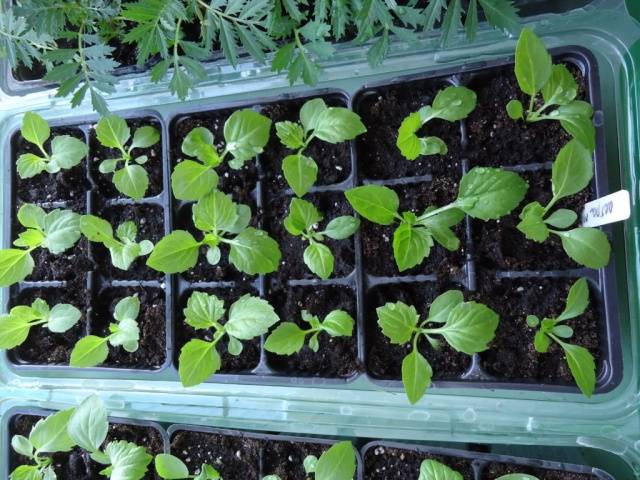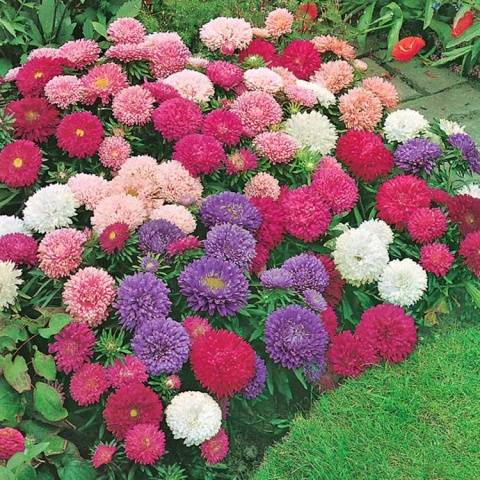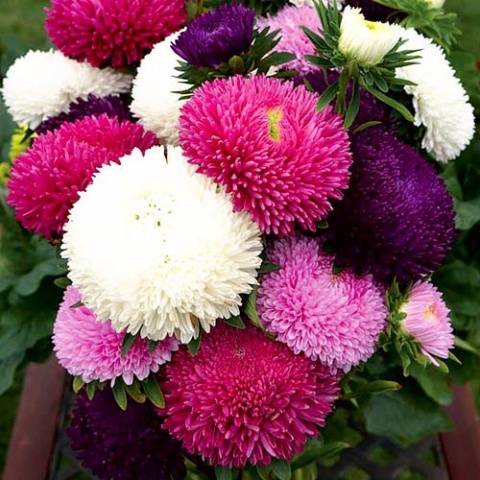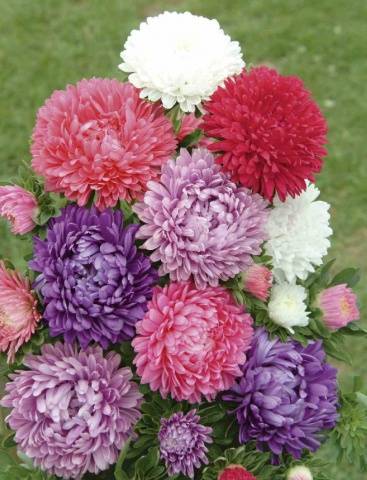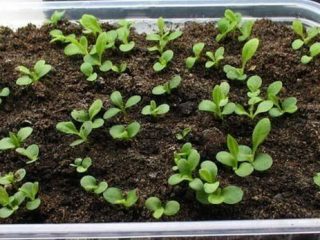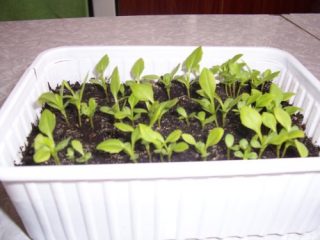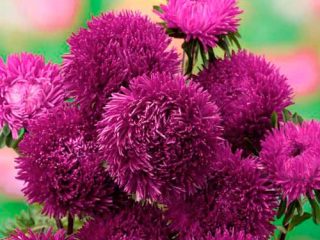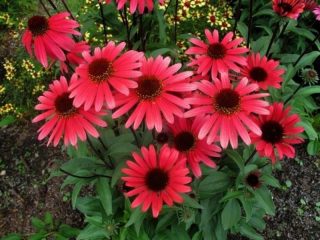Content
Asters are unpretentious annuals that bloom in late summer and autumn. One of the varieties of these flowers is Milady's asters. Their compact bushes take up little space in the garden and produce many inflorescences.
The main condition for growing asters is the right choice of site. The flower grows in sunny areas where there is no accumulation of moisture.
general description
Milady's asters include a group of annual varieties of various shades. The plant is herbaceous, stunted, compact, up to 25 cm high, with simple leaves. Many lateral shoots extend from the main stem of the flower.
Large spherical inflorescences are formed on the bushes, resembling a peony in shape. Terry petals, slightly bent inside the bud. The size of the inflorescences is from 8 to 10 cm. Flowering lasts from July to September.
The mixture of Milady's asters includes varieties of certain shades:
- pink;
- white;
- red;
- purple;
- blue;
- lilac;
- purple.
The Milady aster is characterized by resistance to disease and unfavorable climate. Plants tolerate cold snaps, are able to develop in garden soil.
Flowering begins 2 weeks earlier than other varieties. Asters can bloom in full sun and partial shade. If necessary, you can transplant the bushes, the plants quickly adapt to new conditions.
Milady's asters are suitable for decorating borders, mixborders, multi-flower beds. Plants are planted along fences and buildings. Planting in pots or flowerpots is allowed, which can be placed on a loggia or balcony.
When you combine Milady's white aster with bright varieties, contrasting bouquets are obtained. Bouquets made up of monophonic inflorescences look organically.
Cut flowers do not fade in water for 15 days. They are used to create autumn bouquets. Plants have a strong peduncle and a rich color range.
Photo of Milady aster mix of colors:
Seedling method
Annual asters are grown from seeds. The most reliable way is to obtain seedlings at home, which are transferred to an open area. For growing flowers, a substrate is prepared, and the seeds are processed. Seedlings are provided with certain conditions to avoid stretching and form healthy plants.
Seed and soil preparation
When grown from seeds, Milady's aster is planted in March-April. A light fertile substrate is preliminarily prepared. Its functions will be performed by ordinary garden soil fertilized with humus. Another option is to use purchased land.
Before planting Milady's asters, the soil is steamed in a water bath for disinfection. The soil for plants can be left for several days on a balcony or outside in sub-zero temperatures.
Additionally, the planting material is dipped into a fungicide or potassium permanganate solution. Aster seeds Milady remain viable for 2 years. It is best to use fresh seeds, then the sprouts will appear much faster.
The soil is moistened and poured into boxes or cassettes with cells 3-5 cm in size. With the cassette growing method, picking of seedlings can be avoided.
Plant seeds are placed with an interval of 2 cm and buried by 1 cm. A thin layer of soil or sand is poured on top. The containers are covered with plastic wrap to obtain a greenhouse effect.
Active germination of aster seeds occurs at a temperature of 20 ° C. Seedlings will appear in 10-14 days. During this period, the film is periodically turned over to provide the plants with access to fresh air. The soil is kept moist.
Aster seedlings Milady mix of colors in the photo:
Seedling care
When shoots appear, the film is removed from the containers. Seedlings of Milady's asters provide certain conditions:
- temperature 16-18 ° C;
- regular ventilation of the room;
- watering with warm water;
- lighting for 12-14 hours.
The soil in containers is watered as it dries. For plants, warm, settled water is used.
If necessary, install additional lighting if the aster seedlings do not have enough natural light. Phytolamps are placed at a distance of 30 cm from the seedlings, which are turned on in the morning or in the evening.
With the development of the first pair of leaves, asters dive in separate containers. If cassettes were used, then picking can be avoided.
Plants are hardened 3 weeks before being transferred to a permanent place. First, the window is opened in the room for 2-3 hours to ensure the flow of fresh air.
Then the containers with seedlings are transferred to a loggia or balcony. As a result, plants will be able to quickly adapt to new conditions.
Landing in the ground
Asters are planted in open ground in mid-May. The flower prefers drained, light soils and well-lit areas.
Aster does not tolerate stagnant moisture, so the flower garden is arranged on a hill or on a flat area. The planting site is prepared in the fall, when they dig up the soil, add humus or compost.
Wells are prepared for planting plants. They are placed in increments of 30 cm. 35 cm are left between the rows with asters. The seedlings are transferred to the planting holes, the roots are covered with earth. The last step is to water the plants abundantly.
Photo of the Milady aster after the pick:
Seedless way
In the southern regions, when growing Milady asters, seeds are planted in open ground in spring or autumn. Seeds take longer to germinate in natural conditions. Therefore, the timing of flowering may shift. During podzimny planting, the planting material undergoes natural stratification, and the plants sprout quickly in the spring.
Spring planting
Before planting asters in open ground, the seeds are kept in warm water for 24 hours. For work, choose a warm day in May or June.
Furrows are made on the surface of the soil with a depth of no more than 1.5 cm. The seeds are placed in increments of 10 cm, a thin layer of soil is poured on top and the garden bed is watered abundantly.
If there is a possibility of frost, then the plantings are covered with foil overnight. The emerging seedlings are thinned out. When the flowers grow up, they can be planted around the site.
Winter landing
Milady's asters are planted in autumn in October-November. Podwinter plants are resistant to diseases and weather conditions.
For planting, furrows are prepared with a depth of 1-2 cm, along which seeds are scattered. Pour soil and a layer of mulch from compost or dry leaves on top. In winter, under the influence of low temperatures, plant seeds will undergo natural stratification.
After the snow melts, the mulch is removed. Until the end of the frost, asters are kept under agrofibre. The grown flowers are thinned out or planted.
In the photo of the Milady aster in the flowerbed:
Flower garden care
Asters require minimal care, including the introduction of moisture and nutrients. To make the flower garden look well-groomed, you need to weed regularly weeds... Diseases and pests rarely affect these plants; special preparations are used to protect against them.
Watering
Asters are watered as the soil dries up. Stagnant moisture is detrimental to plants, as the root system decays. With insufficient watering, asters dry out, and the inflorescences lose their decorative effect.
The intensity of watering is increased in drought. Water the flower garden with warm, settled water. Morning and evening hours are best suited for watering asters.
After watering the plants, the soil is loosened to a depth of 5 cm to enrich the soil with oxygen, improve the absorption of moisture and nutrients. Weeds are sure to weed.
Top dressing
On poor soils, aster lacks nutrients. For feeding, solutions are prepared consisting of mineral components.
The scheme of feeding asters of the Milady variety:
- 2-3 weeks after transfer to an open area;
- when the first buds appear;
- before the onset of abundant flowering.
The first plant feeding includes 30 g of urea, 20 g of potassium sulfate and 40 g of superphosphate. The substances are dissolved in 10 liters of water, after which the plantings are watered at the root. Milady's asters do not respond well to fresh organic fertilization: mullein or bird droppings.
For subsequent treatments of the flower garden, similar solutions are prepared, with the exception of urea. Phosphorus and potassium strengthen the root system of plants, promote abundant flowering, increase resistance to weather and disease.
Pink, purple and white aster Milady in a bouquet:
Diseases and pests
Subject to agricultural technology, Milady's asters rarely get sick and are not very susceptible to pest attacks. Diseases appear with high humidity and the use of low-quality planting material.
The most dangerous disease for a flower garden is Fusarium disease. It is spread by a fungus that causes plants to wilt. There are no effective treatment methods against fusarium, therefore, special attention is paid to its prevention.
On acidic soils, Milady's asters suffer from black legs. Plant stems begin to rot at the base. After removing diseased bushes, the soil is disinfected with a solution of potassium permanganate.
For the Milady aster, the greatest threat is represented by meadow bugs, slugs, spider mites, scoops and aphids. Insects carry diseases, feed on sap or plant roots. As a result, the flower dies.
Insecticides Fundazol, Karbofos, Pyrethrum are used against pests. On their basis, preparations are prepared for spraying plantings.
Autumn care
As the inflorescences and leaves of the aster wilt, they are removed. Annuals after flowering are dug up and burned to eliminate possible pests and pathogens.
First, you can collect seeds for planting next year. To do this, you should wait until the inflorescences wither and darken. Seeds with fluff will appear in the center of the aster. Planting material is stored in a paper or cloth bag.
Conclusion
Astra Milady is an ideal option for decorating multi-flowered flower beds and autumn bouquets. The plant is unpretentious, tolerates drought and temperature fluctuations without problems. Using a mixture of colors allows you to grow flowers of various colors.
Asters are propagated by seeds. In cool climates, seedlings are first obtained and transferred to flower beds. Under favorable weather conditions, you can plant seeds immediately in a permanent place. Plant care includes watering, loosening the soil and occasional feeding.

